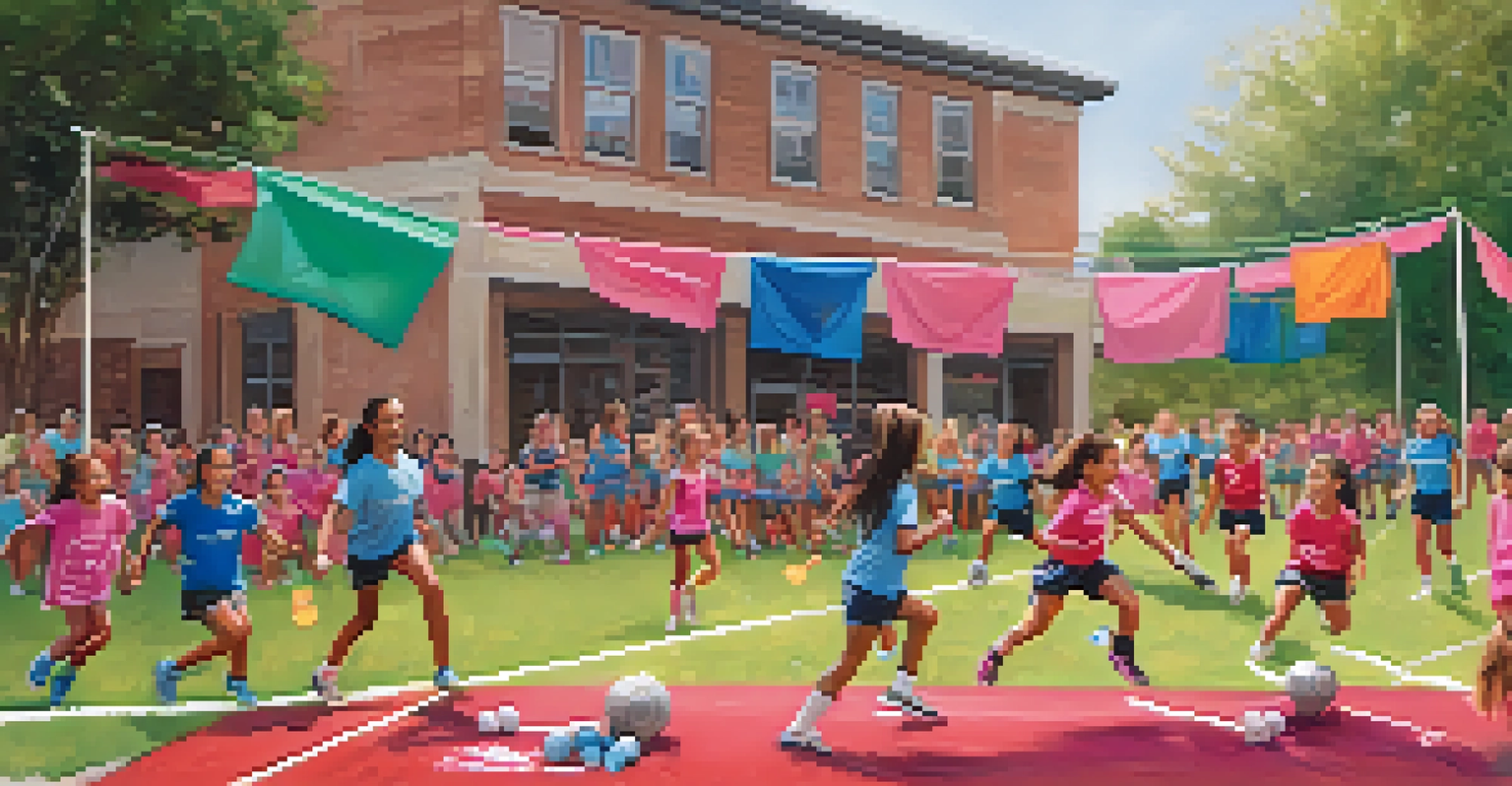The Rise of Women's Sports in North Carolina Colleges

Historical Context of Women's Sports in North Carolina
Women's sports in North Carolina have a rich history that dates back to the early 20th century. Initially, female athletes faced significant barriers, often being sidelined in favor of their male counterparts. However, the passage of Title IX in 1972 marked a pivotal moment, mandating equal opportunities in education and sports for women. This legislation paved the way for increased visibility and support for women's athletics across colleges in the state.
The future belongs to those who believe in the beauty of their dreams.
As societal attitudes began to shift, more women started to participate in competitive sports at the collegiate level. Institutions like the University of North Carolina at Chapel Hill and North Carolina State University began to invest in women's programs, recognizing the potential and talent within their student bodies. This investment not only helped to cultivate athletic programs but also fostered a sense of community and pride among female athletes.
Today, historical achievements in women's sports are celebrated, with alumni often returning to share their experiences and inspire current athletes. These narratives play a crucial role in motivating young women to pursue sports, demonstrating the progress made and the road ahead. The legacy of these pioneers continues to influence and shape the landscape of women's athletics in North Carolina.
Current Participation Rates and Popularity
In recent years, there has been a notable increase in participation rates among women in collegiate sports across North Carolina. Schools are witnessing a surge in female athletes, with programs in soccer, basketball, and track and field seeing record numbers. This growth can be attributed to a combination of increased recruitment efforts, scholarships, and the rising popularity of women's sports on national television.

Colleges are also prioritizing the development of robust support systems for female athletes, including coaching, facilities, and wellness programs. These enhancements not only improve performance but also create a more inclusive and supportive environment, encouraging even more women to get involved. As visibility continues to grow, so does the excitement surrounding women's events, drawing in larger crowds and generating greater interest.
Title IX Transformed Women's Sports
The passage of Title IX has led to significant advancements in funding, facilities, and scholarships for women's athletics in North Carolina.
Moreover, the success of North Carolina's women’s teams in various championships has elevated the status of women's sports. Victories and strong performances serve as a rallying point, inspiring younger generations to aspire to athletic excellence. As more young women see role models in their local teams, the cycle of participation is likely to continue growing.
Impact of Title IX on Women's Sports
Title IX has been a game changer for women's sports in North Carolina, ensuring that gender discrimination in athletics is addressed. This federal law has led to significant advancements in funding, facilities, and scholarships for women's programs. As colleges strive to comply with Title IX, they have developed more equitable athletic departments, creating opportunities that were once out of reach for many female athletes.
Sports do not build character. They reveal it.
The impact of Title IX extends beyond just participation; it has transformed the perception of women's sports in society. With more female athletes receiving recognition and support, there is a growing appreciation for their skills and achievements. This newfound respect helps to break down stereotypes and encourages a culture where women athletes are celebrated, not just tolerated.
Despite the progress made, challenges remain. Some programs still struggle with resource allocation and visibility compared to men's sports, highlighting the ongoing need for advocacy and support. By continuing to champion Title IX principles, North Carolina colleges can further enhance the landscape for women’s athletics and ensure that future generations of female athletes have access to equal opportunities.
Success Stories of North Carolina Female Athletes
North Carolina has produced numerous successful female athletes who have made their mark in collegiate sports and beyond. Athletes like Mia Hamm, a UNC alumna, have not only excelled in their respective sports but have also become influential figures in advocating for women's athletics. Their achievements inspire young athletes across the state to pursue their dreams, showing that success is attainable regardless of gender.
Moreover, these success stories are not limited to elite athletes; they encompass a diverse range of individuals who have overcome obstacles to excel in their sports. From local heroes in high school teams to collegiate champions, each story adds to the rich tapestry of women's sports in North Carolina. These narratives foster a sense of community and pride, encouraging more women to take up sports.
Community Support Boosts Participation
Grassroots engagement from local organizations and fans has created a supportive environment, enhancing visibility and participation in women's sports.
Colleges often highlight these athletes in marketing campaigns and events, which helps to create a narrative of empowerment and achievement. By showcasing these role models, institutions are not only celebrating past successes but are also paving the way for future generations to thrive in athletics.
Challenges Facing Women's Sports Today
Despite the progress, women's sports in North Carolina still face several challenges that can hinder growth. Funding disparities between men's and women's programs persist, affecting training, travel, and overall athlete experience. This imbalance can limit the potential of female athletes, making it crucial for colleges to prioritize equity in their athletic budgets.
Additionally, societal perceptions and media coverage of women's sports can sometimes lag behind those of men's sports. While there has been increased visibility, many women's events still struggle to attract the same level of attention and sponsorship. This lack of exposure can impact recruitment and fan engagement, creating a cycle that is difficult to break.
To address these challenges, it is essential for stakeholders, including colleges, sponsors, and media, to work collaboratively. By promoting women's sports and ensuring equitable resources, they can help create a more level playing field. Continued advocacy and support are vital to overcoming these obstacles and fostering a sustainable future for women's athletics.
Community Support and Engagement in Women's Sports
Community engagement plays a significant role in the rise of women's sports in North Carolina. Local organizations, businesses, and fans have rallied behind women's teams, creating a supportive environment that amplifies their efforts. This grassroots support not only enhances visibility but also fosters a sense of belonging and pride among female athletes and their communities.
Events such as community fundraisers, youth sports clinics, and awareness campaigns have successfully brought people together to celebrate women's athletics. By involving the community, colleges can create a network of support that encourages young women to participate in sports and aspire to collegiate competition. These initiatives help to build a pipeline of talent that will sustain women's sports in the future.
Future Looks Bright for Women Athletes
With increasing investment and awareness, the future of women's sports in North Carolina is set for growth and greater opportunities.
The positive impact of community support is evident during games, where attendance for women's events is steadily increasing. As local fans cheer on their teams, it creates an electric atmosphere that boosts player morale and enhances the overall experience. This sense of camaraderie not only uplifts the athletes but also encourages more people to engage with women's sports.
The Future of Women's Sports in North Carolina
Looking ahead, the future of women's sports in North Carolina appears promising. With a growing emphasis on equity, more colleges are likely to invest in women's athletics, leading to enhanced facilities, coaching, and opportunities. This increased investment will not only attract top talent but will also help retain athletes who might otherwise consider leaving the sport.
As awareness around the importance of women's sports continues to rise, there will be greater opportunities for sponsorship and media coverage. This shift could lead to more lucrative contracts for female athletes and increased visibility for women's events, creating a ripple effect that benefits all levels of competition. With more role models emerging, young girls are likely to see themselves in sports, further fueling participation.

Ultimately, the trajectory of women's sports in North Carolina hinges on continued advocacy and support from all stakeholders. By fostering an inclusive and equitable environment, the state can ensure that women's athletics not only thrive but also continue to inspire future generations of female athletes.